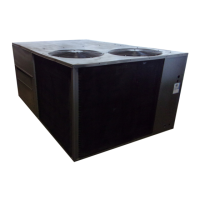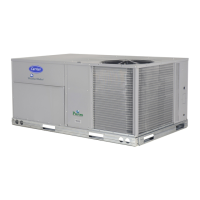/
o
\
GRY e ORN
-- -- _GRY _e RED
E
E
UA _ V_COUr
gNT_tA_ _'Y
p_: _ VAC
_: loA F_ I¢ P_hy_!
24 VAC So_a Po_
0
f
O_'J1
0 0
....... (OR UNIT GROUND)
*Used with Differential Enthalpy Control only.
Fig. 23 -- Typical Wiring Schematic -- Carrier Rooftop Unit with PremierLink TM Controls
DIFFERENTIAL ENTHALPY CONTROL (Fig. 24) --
Differential enthalpy control requires both an enthalpy switch/
receiver (33CSENTHSW) and an enthalpy sensor
(33CSENTSEN). The enthalpy switch/receiver is mounted in
the outdoor air inlet and calculates outdoor air enthalpy. The
enthalpy sensor is mounted in the return airstream and calcu-
lates the enthalpy of the indoor ai_:
The enthalpy switch/receiver energizes the HI Enthalpy re-
lay output when the outdoor enthalpy is greater than the indoor
enthalpy. The LOW Enth_dpy terminal is energized when the
outdoor enth_dpy is lower than the indoor enthalpy. The relay
output is wired to the unit economizer which will open or close
depending on the output of the switch.
NOTE: The enthalpy calculation is done using an average _flti-
tude of 1000 ft above sea level.
Mounting -- Mount the enthalpy switchheceiver in a location
where the outdoor air can be sampled (such as the outdoor air
intake). The enthalpy switch/receiver is not a NEMA 4 enclo-
sure and should be mounted in a location that is not exposed to
outdoor elements such as rain, snow. or direct sunlight. Use
two field-supplied no. 8 x 3/4-in. TEK screws. Insert the screws
through the holes in the sides of the enth_dpy switch/receive_:
Mount the enthalpy sensor in a location where the indoor air
can be sampled (such as the return air duct). The enthalpy
sensor is not a NEMA 4 enclosure and should be mounted in a
location that is not exposed to outdoor elements such as rain or
snow. Use two field-supplied no. 8 x 3/4-in. TEK screws. Inset1
the screws through the holes in the sides of the enthalpy sensor:
Wiring -- Carrier recommends the use of 18 to 22 AWG
twisted pair or shielded cable for all wiring. All connections
must be made with I/4-in. female spade connectors.
The PremierLink TM board provides 24-vac to power the en-
thalpy switch/receive_: Connect the GND and 24 VAC termi-
nals on the enth_dpy switch/receiver to the terminals on the
transformec On some applications, the power from the econo-
mizer harness can be used to power the enthalpy switch/receiv-
e_:To power the enthalpy switch/receiver from the economizer
harness, connect power of the enthalpy switch/receiver to the
red and brown wires (1 and 4) on the economizer hmness.
Connect the LOW" Enthalpy terminal on the enthalpy
switch/receiver to J4 -- pin 2 of the PremierLink control on the
HVAC unit. The switch can be powered through the Premier-
Link control board if desired. Wire the 24 VAC terminal on the
enthalpy switchheceiver to J4 -- pin 1 on the PremierLink
control. Wire the GND terminal on the enthalpy switch/
receiver to Jl -- pin 2 on the PremierLink control. The HI
Enthalpy termimd is not used. See Fig. 23.
Connect the 4-20 mA IN terminal on the enthalpy switch/
receiver to the 4-20 mA OUT terminal on the return air en-
thalpy sensor: Connect the 24-36 VDC OUT terminal on the
enthalpy switch/receiver to the 24-36 VDC IN terminal on the
return air enth_dpy sensoc See Fig. 24.
16

